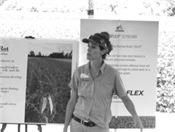|
Union City Field Day Takes Research To Farmers
BETTY VALLE GEGG-NAEGER
MidAmerica Farmer Grower
UNION CITY, TENN.
A variety of presentations were made to educate the farmers and others who attended the 20th Annual Monsanto Field Day here recently.
Among the presenters were Dr. Chad Lee, UK Extension Agronomist and Director of the Grain and Forage Center of Excellence at Union City. Water use in corn was the focus of his talk.
“Corn requires somewhere around 25 inches of water to grow during the season, but that assumes you’re going to get timely rainfall events. We’ve been doing some irrigation studies to find out where to fill in gaps in our rainfall, because our rainfall is not timely. Sometimes we get way too much in one shower and then we don’t get enough for three weeks. So if we can fill in those gaps here and there we can really improve our overall yields. We found in the last few years with our experiments that small amounts of irrigation can make a big difference in our bushels at the end of the season.”
He’s also been looking at populations trying to determine the ideal population for various soil types. This, also, all goes back to water.
“If you’re in a really dry year, the lowest populations we tested are the best ones. Those would be around 20,000 seeds per acre.
“However, in a really good year without irrigation and there’s pretty good rainfall events, the best populations are around 40,000,” Lee said. “Then yields go from 200 to 300 bu/a; and if you’re irrigating and doing a pretty good job of irrigating, we’ve done some really high population studies and in those studies our best populations are from about 42,000 to about 60,000 plants per acre.”
He stressed that this is not considered the most economical focus, but just the optimum populations to top out on the yields.
“I think that tells us that water is extremely important when we’re trying to make a decision on where our populations should go; and for most of us we’ve got to make our decision on populations in the spring, well before we know what kind of rain we’ll have in July. Right now, we are forced to use an average population which is low enough to avoid a disaster in a dry year but high enough to capture yield potential. We’re really struggling to determine what that right population would be,” he summed.
Larry Steckel, Extension weed specialist, University of Tennessee in Jackson, expounded on the status of the weed control in the state in light of the new herbicide tolerant technologies, most notably the Extend technology.
“In Tennessee this year, we‘re almost all in when it comes to Extend in soybean,” Dr. Steckel began. “My best estimate is about 95 percent of our soybean acres are Extend. So we have 1.8 million acres of soybeans in this state and if you do the math that leaves us about 100,000 acres that are Liberty Link, Roundup Ready or conventional beans. Most of those 100,000 acres of non-Extend beans, Liberty Link acres were planted in tobacco counties, Macon, Robertson, Montgomery counties, and that was part of the education effort. We just advised them not to be drifting dicamba on specialty crops like tobacco. It’s just too high value, there’s just absolutely no room for air.
“They pretty much took that to heart, most of them are raising Liberty Link beans there; or if they had Extend beans there, they weren’t spraying dicamba and they have the luxury to do that. They don’t have near the palmer amaranth problem that we have in West Tennessee. They can get by better than we can, they can make Roundup and Prefix still work well.
Many of the soybeans are in West Tennessee and, unfortunately, a lot of those Liberty Link bean acres do have drift, similar to what they had last year.
“We do have those issues out there, but the overall volume of them are way down. That’s translated to a lot less complaints to the Tennessee Department of Agriculture. Last year we had 70 official complaints, we have about half that this year, about 40 to 41; although recently there was a little flurry of them, but about half that on soybeans. Only a few of the complaints now are farmers fussing about other farmers drifting. It’s mostly homeowners and specialty crops, so that dynamic has changed to where folks got maybe a little Dicamba drift on their garden, landscaping or trees. That is happening and its something we do need to address.”
While those are some of the bigger issues, another take-home message concerns a big uptake lately on grass issues, weed and grass species specially barnyard grass, Goosegrass and johnson grass. Goosegrass and johnson grass were identified as glyphosate resistant a few years ago. More recently barnyard grass was found resistant, and those are really becoming a problem in the Extend crops, actually in all the crops.
“Roundup is not carrying the mail for us anymore so we’re more moving toward the old gramiticides commonly used back in the 1980s like Select,” Steckel added. “Also, recently we have had some issues where Select might not be working so well. These are some of the issues we’re trying to tackle with some research in the greenhouse to assess if it’s resistant and, if it is, what other options we might use.”
Jeremey Taylor, Regional Agronomy Lead for Monsanto in Michigan, Indiana and Kentucky, spoke at a stop about new technologies and what those technologies can do for farmers in their farming operation. He also joined with Dr. Heather Kelly from the University of Tennessee to talk about diseases, soil borne pathogens and nematodes, which is a big, big ticket.
“They call it the million dollar pest,” he said.
“One big focus of Monsanto’s pipeline is really honing in on the sustainability of our products. That means we’re building our pipeline to assist our customer, to understand the customer’s needs so that we can truly provide them a consistent and solid agronomic solution for their acres,” Taylor said.
Heather Kelly, Field Crops Plant Pathologist with the University of Tennessee, discussed technology updates and disease management, focusing on the silent yield robbers, those pathogens that are below ground.
“These are the yield robbers we don’t always notice or think about, so I highlighted some of those, particularly charcoal rot, sudden death syndrome and soybean cyst nematode,” Dr. Kelly said. “Management practices for those always start with variety selection, followed by seed treatments, if available. However, the bottom line comes down to deploying the technologies for those diseases only when you know you have the disease, the issue in your field.
“For soybean cyst nematode in particular, that means sampling your field,” Kelly said. “So we’re doing a big soil survey campaign this year in Tennessee for free. Tennessee farmers can submit a soil sample to us at West Tennessee in Jackson and we’re going to screen for all pathogenic nematodes including charcoal rot from samples sent in this fall.”
Nematodes can quickly reproduce in one season. One cyst can contain at least 200 eggs. If you start with one cyst the beginning of the season and you look at just three generations, and only a viability factor of 1 percent in each of those generations, you still get just under 40,000 eggs at the end of three generations. Also, you can have up to five or six generations in a season and definitely much greater viability than 1 percent.
“It is recommended to continually monitor your field, that way, even if you have no problem now you’ll see it if one does occur,” Kelly recommended. “Then also you’re gauging your own management practices, you’re better understanding what you’re doing in the field that’s being positive or possibly negative on your soil pathogens. While right now, I can only guarantee this year free testing for all pathogens, nematodes and charcoal rot, I’m hoping we’ll continue at least to 2019. We’ve always had free sampling for soil cyst nematode for Tennessee farmers anytime throughout the year, but it’s recommended to sample in the fall. That is the time period you really want to sample, anytime after harvest and before first freeze.”
Specific information about taking soil samples and submitting them can be found at UTcrops.com, under Soybean: Diseases & Nematodes. Outside of Tennessee, sample processing is $25.
Angela McClure, Extension Corn and Soybean Specialist with the University of Tennessee, presented a talk about yield components in soybean, what goes into yield for soybeans and some of the research that’s been done.
“We try to manipulate specific things to try to get better yields,” she said. “Based on some of our work, there are some no cost things a farmer can do that set them up for higher yields. One is planting early, as early as soil temperature and moisture allow them to get in. That gives them that wide window and we have seen increases in yield just by that early planting practice.
“Another one similar to that would be row spacing. With narrow rows, we can get some yield increase with soybean varieties that have some potential to branch. We’re also doing a better job spacing plants within the row with those narrow row beans, and it’s at no cost to the farmer, which we really like. We’ve looked at things like adding nitrogen into the system. We have had some success with small increases in yield, but usually the practice basically pays for the cost of the nitrogen. We’re not getting large yield increases and it’s probably not an economical thing to do.
“I think our take on what goes into yield is it’s kind of a system. It’s picking good genetics that are going to provide that good base, and it’s adding some of these other things that add incremental yields on top of that.
“Obviously soil fertility is aways important, making sure you don’t fall low on potash,” she summed. Basically, a combination of things go into yield rather than one thing providing a really large increase.” ∆
BETTY VALLE GEGG-NAEGER: Senior Staff Writer, MidAmerica Farmer Grower

Dr. Chad Lee, UK Extension Agronomist and Director of the Grain and Forage Center of Excellence
at Union City focused his presentation on water use in corn. Corn requires somewhere
around 25 inches of water to grow during the season.
Photos by Jack Thompson

Heather Kelly, Field Crops Plant Pathologist with the University of Tennessee,
discussed technology updates and disease management, focusing on the silent yield
robbers, those pathogens that are below ground.
|
|